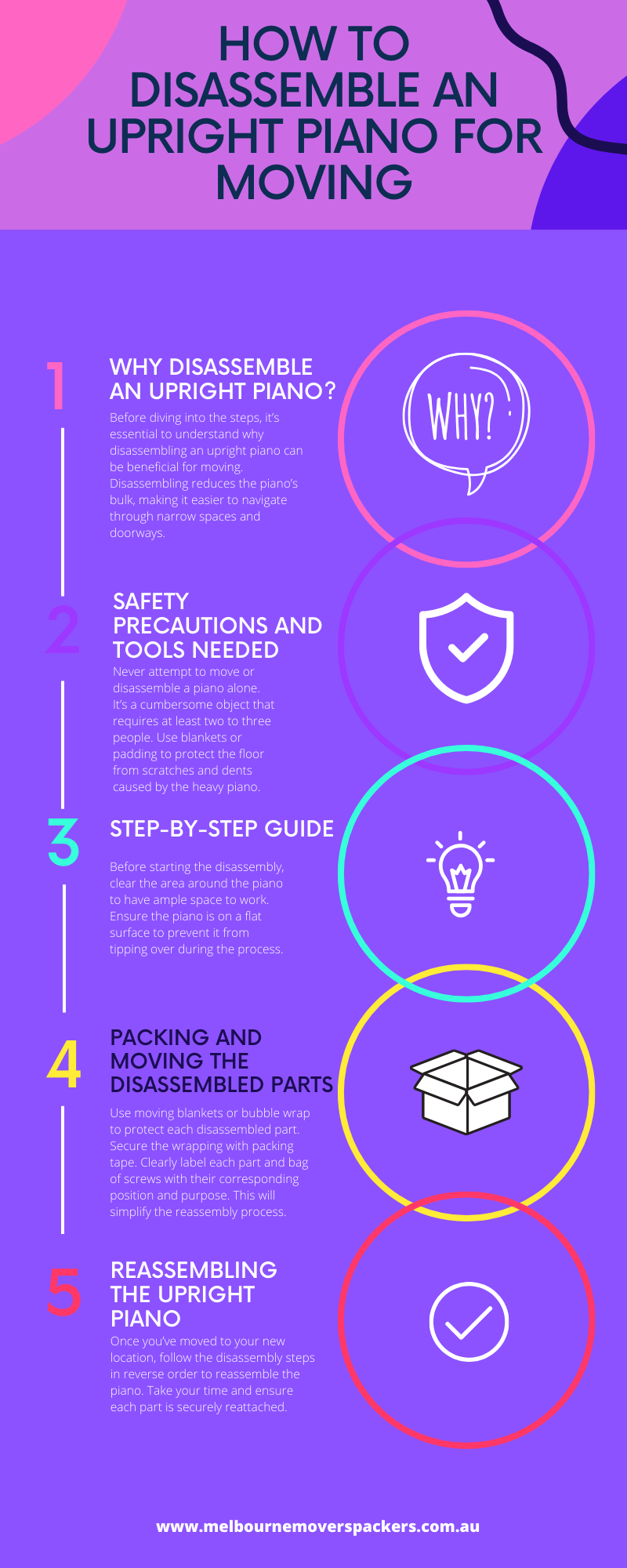Moving an upright piano can be a daunting task due to its size, weight, and delicate components. However, with the right approach, you can disassemble it safely and make the moving process more manageable. In this blog, we will guide you through each step of disassembling an upright piano, ensuring you handle each part with care and precision.
Why Disassemble an Upright Piano?
Before diving into the steps, it’s essential to understand why disassembling an upright piano can be beneficial for moving:
- Easier Handling: Disassembling reduces the piano’s bulk, making it easier to navigate through narrow spaces and doorways.
- Weight Distribution: Removing parts like the lid, legs, and pedals lightens the load, making it easier to carry and reducing the risk of injury.
- Prevention of Damage: Separating delicate components helps prevent damage during transit.
Safety Precautions and Tools Needed
Safety Precautions
- Work in a Team: Never attempt to move or disassemble a piano alone. It’s a cumbersome object that requires at least two to three people.
- Use Proper Lifting Techniques: Bend your knees and keep your back straight while lifting to avoid injuries.
- Protect the Flooring: Use blankets or padding to protect the floor from scratches and dents caused by the heavy piano.
- Wear Protective Gear: Use gloves to protect your hands from sharp edges and heavy components.
Step-by-Step Guide to Disassembling an Upright Piano
1. Prepare the Piano and Work Area
Before starting the disassembly, clear the area around the piano to have ample space to work. Ensure the piano is on a flat surface to prevent it from tipping over during the process.
- Close the Lid: Close the keyboard lid to protect the keys from dust and debris.
- Secure the Lid: Use tape or rope to secure the lid to prevent it from opening during disassembly.
2. Remove the Piano Lid and Music Stand
The lid and music stand are usually the first parts to be removed as they are relatively easy to detach.
- Open the Lid: Carefully lift the lid and use a prop to hold it open.
- Remove Screws: Locate and remove the screws holding the lid hinges in place. Keep the screws in a labeled bag for reassembly.
- Lift Off the Lid: With the help of a partner, lift the lid off the piano and place it on a padded surface.
- Detach the Music Stand: Remove any screws or bolts securing the music stand, and gently lift it off.
3. Disassemble the Piano Legs and Pedals
Removing the legs and pedals reduces the piano’s height and weight, making it easier to maneuver.
- Locate Screws and Bolts: Identify the screws or bolts attaching the legs to the piano body. They are usually found near the base of the piano.
- Remove Screws and Bolts: Use a wrench or screwdriver to remove the screws or bolts, keeping them in a labeled bag.
- Lift Off the Legs: Carefully lift each leg off the piano. You may need to tilt the piano slightly to remove the legs more easily.
- Detach Pedal Assembly: Locate and remove the screws securing the pedal assembly. Gently pull the assembly away from the piano and place it on a padded surface.
4. Remove the Keyboard and Action Assembly
The keyboard and action assembly are delicate components that require careful handling.
- Open the Keyboard Lid: If the lid was secured earlier, untape it and open it to access the keys.
- Locate Screws: Find the screws securing the keyboard cover, usually located at the front of the piano.
- Remove Keyboard Cover: Remove the screws and lift off the keyboard cover, exposing the keys and action assembly.
- Detach the Action Assembly: The action assembly is the mechanism behind the keys that produce sound. Locate the screws or bolts securing it and carefully remove them. Gently lift the assembly out, ensuring no to damage any delicate parts.
5. Disassemble the Piano Back and Cast Iron Plate
The back of the piano and the cast iron plate are integral parts of the piano’s structure and require careful disassembly.
- Locate and Remove Screws: Identify the screws securing the back panel of the piano. They are typically found along the edges.
- Remove the Back Panel: Carefully remove the screws and lift off the back panel. This exposes the cast iron plate and strings.
- Detach the Cast Iron Plate: The cast iron plate is heavy and requires careful handling. Locate and remove the screws or bolts securing it to the piano frame. With the help of a partner, gently lift it out of the piano, ensuring not damage the strings or soundboard.
Packing and Moving the Disassembled Parts
Protect Each Part
- Wrap Each Component: Use moving blankets or bubble wrap to protect each disassembled part. Secure the wrapping with packing tape.
- Label Everything: Clearly label each part and bag of screws with their corresponding position and purpose. This will simplify the reassembly process.
Load and Transport
- Use a Dolly or Hand Truck: Use a dolly or hand truck to move the heavier parts. Secure them with straps to prevent movement during transport.
- Load Securely: Place the disassembled parts in the moving truck, ensuring they are secure and won’t shift during transit.
Reassembling the Upright Piano
Once you’ve moved to your new location, follow the disassembly steps in reverse order to reassemble the piano. Take your time and ensure each part is securely reattached. Having your labeled parts and screws will make this process smoother.
Conclusion
Disassembling an upright piano for moving requires careful planning, the right tools, and teamwork. By following this step-by-step guide, you can safely disassemble your piano, making the moving process more manageable and protecting your valuable instrument. Remember to handle each part with care and attention, and soon your piano will be ready to fill your new home with beautiful music once again.
If you’re short on time and overwhelmed, you can avail the services of professional Melbourne Movers. The professionals will take off all the weight off your shoulders.
Melobourne Movers Packers are best in the smooth home relocation. Book now and get 10% discount on the first move.

Related Articles
Top Tips for a Smooth Move with House Movers in Melbourne
Moving houses must be one of the most stressful things in life. To illustrate, whether you are relocating within town or a brand new neighborhood altogether, there are so many things that pop into mind and thus in one's head to manage. Fortunately, with professional...
9 Tips for Hiring the Best Small Movers in Melbourne
Speaking about moving, the right moving company can make all the difference. If you happen to be based in Melbourne and are looking to make a move—probably one that is of a bit smaller scale—a good small mover will help ensure a seamless and hassle-free experience....
Why Professional Removalists Are Worth the Investment
Moving into a new house or office may be exciting but equally stressful. Mostly, moving tasks involve packing, transporting, and unpacking, activities that can overwhelm one. Whereas some may consider self-management to save on costs, hiring professional removalists...

The Melbourne Movers & Packers Team boasts 5+ years of experience writing informative content about moving and packing. Our team of moving experts understands the hassles of relocating to Melbourne. Get helpful tips and advice for your move here. We are the #1 Removalists in Melbourne.




